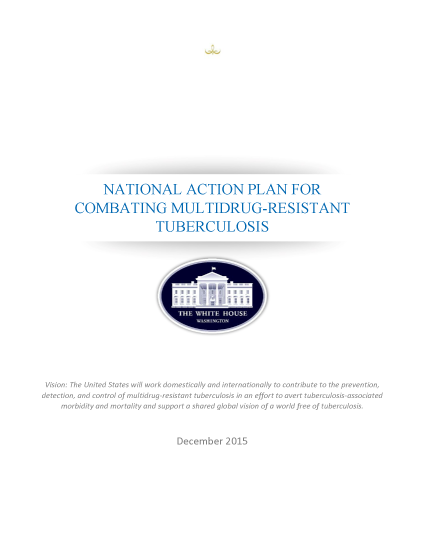- What We Do
- Agriculture and Food Security
- Democracy, Human Rights and Governance
- Economic Growth and Trade
- Education
- Ending Extreme Poverty
- Environment and Global Climate Change
- Gender Equality and Women's Empowerment
- Global Health
- Water and Sanitation
- Working in Crises and Conflict
- U.S. Global Development Lab
Vision: The United States will work domestically and internationally to contribute to the prevention, detection, and control of multidrug-resistant tuberculosis in an effort to avert tuberculosis-associated morbidity and mortality and support a shared global vision of a world free of tuberculosis.
Tuberculosis (TB) kills almost 30,000 people each week. The disease is caused by Mycobacterium tuberculosis (Mtb), which is transmitted through the air from person to person. Currently, more than two billion people, nearly one-third of the world’s population, are estimated to be infected with Mtb (latent TB) and are at risk of developing the disease. TB is curable, but inappropriate treatment can lead to multidrug-resistant TB (MDR-TB), which is resistant to the two most effective anti-TB drugs, and extensively drug-resistant TB (XDR-TB), which is resistant to many anti-TB drugs. This year alone, more than 480,000 people will develop MDR-TB (including XDRTB). Fewer than 20 percent of individuals with MDR-TB access treatment; of that small fraction, fewer than half are cured, due to health systems that are unable to appropriately diagnose and treat the disease. If left unchecked, MDR-TB could erase decades of progress in global TB control, much of it achieved with U.S. leadership and support. Although the vast majority of individuals with TB and MDR-TB live outside the United States, it is critical that the Nation maintain and expand its global efforts to fight the disease, to save the lives of those afflicted with TB, and to prevent the spread of MDR-TB both in the United States and around the world. An MDR-TB outbreak in the United States could have serious consequences due to the costs associated with treating resistant TB. In the United States, the cost to treat and care for a patient with TB averages $17,000 for drug-susceptible TB, $150,000 for MDR-TB, and $482,000 for XDR-TB.
An increase in the number of patients with MDR-TB or XDR-TB could have a dramatic financial impact on State and local health-care systems. Action taken now, while it is still possible to reverse the development and transmission of MDR-TB, will improve health and prosperity around the world. It will also ensure that the health and security benefits derived from decades of strategic U.S. investments in global health are maintained and continue to grow. This National Action Plan for Combating Multidrug-Resistant Tuberculosis (hereafter referred to as the National Action Plan) identifies a set of targeted interventions that address the core domestic and global challenges posed by MDR-TB and XDR-TB. The recommended interventions represent the U.S. Government’s contributions to reversing the worldwide spread of MDR-TB and should inform policy-development processes around the world. The National Action Plan is an effort to articulate a comprehensive strategy, mobilize political will, and spur additional financial and in-kind commitments from bilateral and multilateral donor partners, the private sector, and the governments of all affected countries.
The goals of the National Action Plan are to:
- Strengthen domestic capacity to combat MDR-TB;
- Improve international capacity and collaboration to combat MDR-TB; and
- Accelerate basic and applied research and development to combat MDR-TB.
Implementation of the National Action Plan will focus U.S. Government and partner efforts, to the extent permitted by law, on an ambitious set of targets by applying new and existing scientific and technological evidence and tools, and the expertise and experience gained from decades of fighting TB in the United States and elsewhere. Preventing the development of MDR-TB is paramount to this effort. The National Action Plan builds on existing U.S. Government efforts to support the appropriate treatment of more than 16 million TB patients to prevent development of MDR-TB by achieving and maintaining a 90 percent TB treatment success rate.
In addition to increased MDR-TB prevention efforts, the National Action Plan proposes increasing the number of individuals initiating MDR-TB treatment in the 10 countries with the highest MDR-TB burden.5 The National Action Plan is intended to promote greater coordination of U.S. Government resources—including domestic, bilateral, and multilateral funding—to reduce the domestic and global risk of MDR-TB, increase the American public’s awareness of the threats posed by MDR-TB, and serve as a call to action to encourage bilateral and multilateral donors, the private sector, and affected countries to increase investments in this critical area of worldwide concern. Investments in research and development will contribute to improved treatment outcomes for individuals with MDR-TB through new tools that are easy to implement in existing health systems, better use of existing and newly licensed TB drugs, an enhanced drug-development pipeline, increased availability of rapid assays for TB diagnosis and drug-susceptibility testing, and improved disease surveillance. These actions will contribute to the prevention of further resistance to TB drugs and significantly reduce the global spread of MDR-TB.
The National Action Plan for Combating Multidrug-Resistant Tuberculosis is not intended to be a budget or commitment document. All activities included in the National Action Plan are subject to budgetary constraints and other approvals, including the weighing of priorities and available resources by the Administration in formulating its annual budget and by Congress in legislating appropriations.








Comment
Make a general inquiry or suggest an improvement.